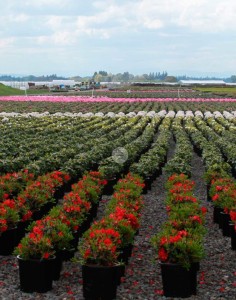Nurseries can better manage their bottom line through proactive forecasting

Kraemer’s Nursery in Mt. Angel, Oregon, produces plants on a vast scale, including the use of an 11-acre gutter-connect greenhouse. Each year the grower carefully constructs a thorough production plan to ensure the best chance of financial success. Photo by Curt Kipp
Business financial planning is one of the most important steps a business can take. So why is it often the most daunting to begin and the easiest to avoid?
For nurseries of all sizes, financial forecasts and budgets can be overwhelming because they encompass every facet of the operation.
As the old adage goes, “If you aim at nothing, you’ll hit it every time.” So goes budgeting and forecasting. But there’s no reason to despair: When you break the challenge into manageable pieces, your financial plan will start to take shape.
Building a budget
Most members of the nursery industry view budgeting as an onerous task, but it is the foundation of strong financial management and an important cornerstone for a successful business. Forecasting income and expenses — at a meaningful and useful level of detail — is simply not done very often, unfortunately.
There are good excuses for this: the production process is quite involved, capturing the cost and cash-flow impact is challenging, projecting long-term landscaping trends is difficult, and operating cycles are very long. These issues, though valid, are the very reasons it is so vital to create a proper budget.
If you can address budgeting during a proactive rather than reactive planning session, you will be rewarded with more accurate budgets and timely financial forecasts.
For most businesses, however, the budgeting process can be disjointed and unsuccessful.
Typically, it starts with compiling data, which can take months to assemble. Generally, office or accounting personnel are gathering the numbers, and attempts to get department heads to participate can be trying. At this point, the plan loses credibility with the team.
By the time a spreadsheet is populated with figures most can agree on, the budget is outdated and needs to be updated with new data — starting the broken process all over again.
Overcoming the budget blues
Start with the basics when creating your budget. As you begin collecting data, involve key members of management whose departments may be impacted.
Spreading the responsibilities across department heads, rather than letting it all rest on the accounting department, increases the validity of the data and the likelihood that team leaders will support the final budget and any necessary operational adjustments that may be needed to keep the business on track.
The following is an abbreviated list of best practices that can help you build your budget:
•Begin by preparing a monthly financial forecast for the next 18–24 months. Ultimately, this should be a three- to five-year monthly projection.
•Project both the income statement and the balance sheet.
•Involve the right people in your organization (from operations, finance, sales, etc.).
•Update the intermediate forecast at the end of every quarter.
•Remember, cash is king. One of the more complex and important aspects of projection is the timing of cash flow. If cash flow is strained, consider forecasting on a weekly or biweekly cycle.
•Know the key performance drivers of your business, such as wages as a percentage of annual sales, or plant mortality rates. Most can be reduced to a units-by-rate calculation — the level most appropriate to manage. For example, rather than broadly predicting a 15 percent increase in sales, determine the specific areas — plant species, geographical sales markets or channels — that will drive this growth.
•Communicate the budget to all key parties.
•Track and report actual results to your forecast.
Once you have compiled your data and formulated a budget with your management, then it is time to align your financial and operating plans. By supporting your financial plan with measurable operating goals, you can track and quantify your performance.
Repeat forecasting for change
Once your budget is in good working order, evaluating it against current results and the changing industry climate is crucial. A forecasting process that can adapt to current market conditions will best serve your business.
Planning is an ongoing process, and continued evaluations are necessary to account for changes. There should be room in your budget to make modifications based on new information as it is received. An open-ended process will lead to insights into product, pricing and cash-flow management.
However, it is important to understand why certain budget expectations were not achieved and to incorporate that knowledge into any budget modifications. Simply not achieving an expectation is not an acceptable reason to modify your budget.
Beyond financial advantages
Nurseries that learn to overcome budgeting challenges gain more than financial rewards. By adopting a streamlined planning and forecasting process, many businesses can reduce errors, save time, and promote department collaboration.
Combining these successful budgeting elements can solidify the connection between operations and sales and finance. It can also foster better communication between department heads, and improve decision making, based on a more accurate financial forecast.
But most important, good financial management puts nursery owners back where they belong — in control of their businesses.


